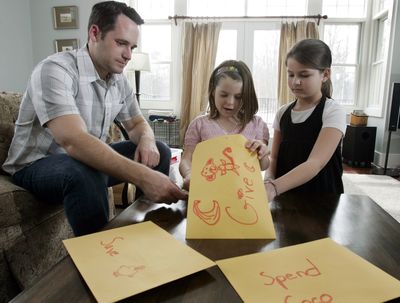More parents are teaching their children money management

Scrawled in big, pink letters across three envelopes are the words “spend,” “save” and “give.” It’s how second-grader Chloe McLaughlin organizes her $8 allowance.
It may sound grown-up for someone who still writes in crayon. But given the state of the economy and runaway levels of personal debt, her parents figured it’s never too soon to teach a little fiscal responsibility.
“We see a lot of people having trouble financially these days, and that made us think about instilling discipline in them early,” says Kevin McLaughlin, a 33-year-old resident of Pine Beach, N.J., who also has two younger children.
Once a casual weekly payment, allowance for many families has evolved into a more structured lesson in money management. Children today might be expected to map out budgets or track spending in exchange for weekly payments as they get older.
For now, the McLaughlins are keeping it simple by letting 8-year-old Chloe decide how she wants to use her allowance. Her decision surprised them; $4 goes to savings, $3 to charity. Just $1 goes toward spending.
“Of course, it’s only been a few weeks, so that could change,” says McLaughlin, who works in marketing.
With a little bit of guidance, your own child’s money savvy might surprise you. Here are some strategies to make an allowance count.
How do I start?
Give young children clear jars, envelopes or piggy banks so they can see their allowance accumulate. This makes the concept of saving tangible.
To provide some guidance, have them divide money into categories, as the McLaughlins did with Chloe. Depending on how sophisticated you want to be, set up two or three jars with labels such as “saving,” “spending” or even “video games” if you want to focus on short-term purchases.
“Some parents are very willy-nilly about it, but allowance needs to be structured,” says Jennifer Hartman, a certified financial planner and principal with Greenleaf Financial Group in Los Angeles. “Don’t just give it to them because the kids are whining about it.”
If you want to preserve the piggy bank tradition, Money Savvy Pig offers see-through piggy banks divided into four compartments: spend, save, donate and invest. A pig is $16.99 at www.msgen.com.
If you haven’t already, open a savings account for your kids so they can make occasional deposits for long-term goals.
How much should I give?
The rule of thumb is $1 for every year of their life, meaning a 10-year-old would earn $10 a week. But that baseline might be too high or low depending on your expectations.
For instance, it might not be enough if you expect your kids to pay for their lunch or after-school snacks. Whatever the figure, it should be enough so they can make decisions about purchases, but not so much that they don’t need to weigh what they buy.
While you want to provide some structure, don’t dictate how they spend every penny. The purpose of an allowance is to let your children experiment and even fail while it’s still harmless.
Lastly, don’t be swayed by whining for more money.
“You have to show them that you can’t always be keeping up with the Joneses,” Hartman says.
Should I tie it to chores?
Tying allowance to routine chores can be an invitation for trouble. It might prompt an expectation of payment simply for making a bed or hanging up clothes.
“That should be part of taking care of family,” says Joel A. Larsen, certified financial planner with Navigator Financial Advisors LLC in Davis, Calif.
Instead, Larsen suggests offering to pay for specific tasks that go above and beyond everyday duties. He pays his 8- and 12-year-old daughters $6 an hour to help with filing duties at the office. They can also wash windows or help out with yard work for extra cash.
“As they get older, they’ll learn that they need to work jobs to earn money,” Larsen says.
Every family is different, of course. You might decide to give your child an allowance with no strings attached. Others might dock pay for failure to perform certain duties, whether it’s helping out around the house or making grades at school.
How should I adjust as kids get older?
Spending can quickly outpace an allowance as your child get older. The obvious way to bridge the gap is to encourage teenagers to get a part-time job.
For major purchases such as a car, consider working out a deal where you pick up a share of the cost.
“They should save up for it one way or another,” says Greenleaf Financial’s Hartman. “Otherwise it could turn into a problem when they get a credit card and just buy whatever they want.”
If you want them to focus on school work, consider giving a quarterly stipend for clothing and other expenses, she says. This can teach kids to be judicious with money over time.
At some point, you might have to consider prepaid debit cards to give teens flexibility to shop online or download songs.
Discover Financial Service’s Current and Visa Inc.’s Buxx cards let parents set spending limits and specify where the cards can be used. You and your child can check the balance online.
The Current card charges a $5 monthly or $50 annual fee. Fees for the Visa Buxx card are determined by the issuer.
If you don’t want to give your kids plastic, let them make online purchases with your credit card then repay you in cash.
What if my budget is tight?
Don’t feel guilty if you have to scale back your child’s allowance. Having children share in any family cutbacks can be an important lesson, says Susan Beacham, founder of Money Savvy Generation, a Lake Bluff, Ill.-based company that makes personal finance products for children.
In fact, she says it will prepare them for the future by giving them a taste of what many adults are going through in the recession.